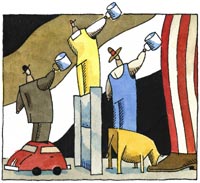Even the most cold-hearted free-marketer would concede the airlines got a tough break in the two-day grounding after the terrorist attacks. Aircraft are frequently kept from the air by bad weather, safety issues and labor disputes. But no management team could be expected to anticipate events on the scale of Sept. 11, or to set aside enough money to cover the revenue shortfalls that followed. So a government bailout, according to the industry and its supporters in Washington, is a reasonable response – a way to insure that a vital industry continues to serve the public. Or is it? While economists and airline experts concede that this is a unique case, there is little enthusiasm for government bailouts in general. The last big one was during the savings and loan crisis of the 1980s; before that, the notable ones were Chrysler Corp. in 1979 and Lockheed in 1971. There is still plenty of debate about the wisdom of those bailouts. Clearly, Congress and President Bush have put themselves in a dilemma this time: They want to avoid interfering with the free market – propping up companies that may have failed even without the attacks. But to avoid that, the bailout plan gives government officials unusual power to choose winners and losers – the role usually reserved for the marketplace. Moreover, the government will become part owner of the companies it helps; it is elbow-deep in the market. Economists generally argue that governments are not as good as free markets at allocating resources and demanding efficiency. “The bottom line is that I would be hard-pressed to come up with a public-interest reason as to why a government bailout of a firm that has failed is appropriate,” said Wharton finance professor
In the days after the attacks, the carriers estimated that industry losses would come to $24 billion in the following nine months as people elected not to fly. Congress quickly authorized $5 billion in cash infusions to shore up the industry through the end of the year, with the funds apportioned according to each carrier’s size. Then it followed with $10 billion in loan guarantees and set up a government compensation fund for victims of the attacks.
On Oct. 5, the White House Office of Management and Budget issued rules to guide distribution of loan guarantees. It leaves substantial leeway to the new Air Transportation Stabilization Board, whose three voting members are Treasury Secretary Paul O’Neill, Federal Reserve Chairman Alan Greenspan and Transportation Secretary Norman Mineta. The rules allow the panel to deny loan guarantees to airlines it views as no longer viable. Essentially, it permits a company-by-company evaluation, focusing on each carrier’s business plan and ability to get funding from the financial markets.
While some critics worry that government support will put poorly run airlines on undeserved life support, others think the opposite is possible – that loan guarantees could actually be used by the strong, such as United and American, to take over the weak, such as U.S. Airways and Continental. That would leave a more consolidated industry that would offer passengers less choice and higher fares.
Why are the airlines in such a fix? For the most part, the industry was highly profitable in the late ‘90s, after a money-losing period following the Gulf War. But recently it has been racking up big losses due to the sluggish economy.
It has always been a cyclical industry, says Wharton business and public policy professor Elizabeth Bailey, who was a commissioner of the Civil Aeronautics Board when the airlines were deregulated in 1978. Airlines have enormous fixed costs and must fill 50% to 60% of their seats to break even, she says. Typically, they add routes and flights during boom periods, and then they are stuck with the resulting high costs when travelers cut back. They must have the capacity to handle the summer vacation demand, and thus have more planes than they can fill during leaner periods the rest of the year. The grounding and subsequent drop in ticket sales did indeed leave them in serious financial trouble, she said.
“They still had to pay the pilots and the lease payments, and when they started flying again they were nearly empty,” she added. “Airlines are very cyclical…and there’s a tendency to over-optimism.”
Yet, said Inman, a government bailout is not necessarily the way to make them operate better, and it’s unfair to competitors who have been better managed. “If I can be sloppy and inefficient, or if I can fail to insure against predictable risk and get bailed out, well then I’m going to be sloppy and inefficient,” Inman said. The airlines, he added, do have access to insurance to cover losses from catastrophes.
Wharton’s Gerald Faulhaber, professor of management and public policy, said American carmakers, which had failed to meet competition from Japan, got government help through tariff protection in the late 1970s but did not respond with meaningful change. “Basically, they just took the money and ran,” he said.
Faulhaber believes bailouts may be appropriate in some extreme cases, but suggests two guiding principals. First, had the company done all it could to avoid the results of the events that got it in trouble? The airline bailout probably passes this test, he said. “[These attacks] come close to an act of God.”
Secondly, has the company made changes to avoid a recurrence of its problems? Chrysler, and later Harley-Davidson, for instance, instituted wholesale management changes, while the late-‘70s auto industry did not.
“On this, I think the airlines lose,” Faulhaber said. If there were no bailout and some of the carriers went bankrupt, that would not necessarily have a severe effect on travelers, he pointed out. Airlines have often operated under bankruptcy protection. Ticket sales typically cover operating costs, though the carriers stop paying their lenders and other creditors – who, he notes, choose to take on the risk of default.
Many people who have studied the industry say it was clear well before Sept. 11 that over-capacity was a problem. The widespread layoffs and route cutbacks announced since the attacks were to some extent needed anyway, said Robert Bruner, business administration professor at the University of Virginia’s Darden Graduate School of Business Administration.
“We are cleaning up mistakes that have accumulated over the past decade,” he noted, citing overestimates of passenger demand and allocation of planes to the wrong markets or wrong routes. “This is always the role of recession. It is to sweep out the excess capacity. It is to sweep out the redundant inventory. It is not a pleasant process. It is the hallmark of free markets that we allow people to fail.”
Thomas Donaldson, professor of legal studies at Wharton, pointed out that “the airlines were victims of their own mismanagement to the extent that their liquidity was dangerously low….If there is indeed inept management, then the market is providing the strong medicine it is supposed to provide.”
The government “does have a role to play when the public stakes are enormously high and the public welfare sits in the balance,” he added. But that is not clearly the case in this instance. “Unless flying people from place to place is a money-losing proposition, there is no reason why the government should be giving [the carriers] money, and there’s every reason smart business people should be giving money.”
When the government does get involved, it should weigh the interests of the passengers, the taxpayers and the companies’ employees, not just those of shareholders, Donaldson said. Any bailout creates the potential for “snowball protectionism,” since the airlines were not the only business hurt by the attacks.
Why not bail out the car rental companies which lost enormous sums with the airport shutdown? Why not the airport hotels and restaurants? Why not the resorts and other tourism destinations? Why not the television networks that gave up hundreds of millions by running advertising-free coverage for days after the attacks?
While the free-market view is that winners and losers should be determined by the marketplace, many who are familiar with the airlines note they are not in a free market in the classic sense. Carriers are dependent on publicly-run airports and the allocation of a finite number of gates. It is not possible for an entrepreneur to create a supply of gates to compete with existing airports, and it would be extraordinarily risky for a start-up airline to buy aircraft, even at fire-sale prices in bankruptcy court, if it did not have gates. Because the barriers to entry are so high, there are only nine major U.S. carriers, though there are dozens of small ones.
Moreover, the government already interferes with the market in the name of the public interest, as in July, when it denied on anti-trust grounds the proposed takeover of U.S. Airways by United. And, of course, the government interfered in the free market by grounding the industry Sept. 11.
If a number of major carriers were to go under, it is not at all certain that new companies would buy their planes and hire their workers, preserving a competitive market, said Bruce Allen, professor of business and public policy at Wharton. “The concern is that it would be United and American that would buy the gates. Who could come in and buy the assets of a Delta or a Continental except for a big guy?” The public-interest issue is whether it would be good to have a virtual duopoly, he noted. Indeed, the Justice Department cited this concern in denying the United-U.S. Airways deal.
At most airports, added Bailey, dominant carriers have received long-term rights to gates in exchange for helping upgrade facilities. In a bankruptcy, gates would be a key asset the court would want to sell to the highest bidder. That would likely be a big, rich airline rather than a cash-strapped startup, she said.
Given the unusual circumstances of this case, a limited bailout may be wise, suggested Bailey, who hopes the free-market philosophy often expressed by Greenspan and O’Neill will keep the stabilization board from overdoing it. “But,” she said, “it’s a little scary to me.”


